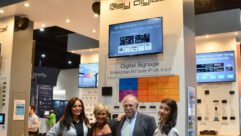
— Tsinberg’s innovation, with foundational contributions to digital television broadcasting, DVD, DVR and video streaming, now extends to the core of Key Digital’s product portfolio: IP-based digital video management, HDMI, HDBaseT and CAT-wired signal and control distribution and extension —
MOUNT VERNON, NY – Key Digital is celebrating the 35th anniversary of company founder and president Mikhail “Mike” Tsinberg receiving his first U.S. patent. That patent, which helped usher in the global adoption of high-definition television (HDTV) broadcast, has grown over the years to a portfolio of more than 40 patents for Tsinberg. His innovations were not only foundational to the initial development of HDTV digital TV broadcasting, but also helped establish the technology behind the digital video recorder, the digital video disc, digital TV streaming and, in 1999, the digital video distribution amplifier, the product that launched Key Digital.
Today, Key Digital is a prospering and innovative manufacturer of sophisticated, programming-free digital AV hardware and software based on Tsinberg’s extension of his expertise to include IP-based digital video management and HDMI, HDBaseT and CAT-wired signal and control distribution and extension. “We’re a connectivity company,” Tsinberg says, “providing digital video processing and signal distribution between sources and displays,” including flexible multi-view displays and video walls.
Born in the former Soviet Union in what is now Ukraine, Tsinberg studied a broad range of technologies at the Rybinsk Aviation Technology Institute near Moscow. “When I graduated, I was more interested in radar than anything else,” he recalls. “I never thought my profession would be in television, but radar and television, the way they work, are very similar.”
With difficult political, personal and career opportunities prospects in the USSR, Tsinberg was able to exit the USSR as a political refugee in 1980 and subsequently worked on a security camera production line and as a television repairman in the NY and NJ area before taking a job with French manufacturer Thomson-CSF at the company’s broadcast electronics R&D lab in Stamford, CT. Three years later, Tsinberg was hired by Philips Research Laboratories in Westchester County, New York, where his extensive knowledge and out-of-the-box thinking led to his first patent.
At the time, the United States and Japan were competing for dominance in the emerging HDTV market, he says. U.S. broadcasters objected to the prospect of having to switch to Japan’s satellite analog HDTV delivery system, MUSE. “I recall thinking, ‘You don’t need this fancy satellite system for HD. You can use terrestrial broadcast towers to broadcast high-definition by using unused frequency space,’” says Tsinberg, whose initial patent, granted in 1987, defined a method for transmitting an analog HD signal alongside existing NTSC broadcasts.
He then proposed transmitting HD as a digital signal, he says, building on his work with weapon telemetry systems in the USSR. “That opened a lot of doors, because digital can be broadcast at very low power and create very little interference. Digital is a beautiful way of transmitting something useful in a noisy channel.” The U.S. concept was refined into separate, simultaneous transmission that triggered the era of digital television broadcasting and the eventual sunsetting of the analog NTSC transmission method to make way for today’s ATSC digital standard. Tsinberg received a slew of patents while at Philips through the early 1990s for developing methods and technology that improved the transmission and quality of high-definition television signals.
After working at Philips on a digital video cassette recorder, which never came to market but won Tsinberg another patent, he moved on from Philips to join Toshiba in the mid-1990s, where he helped spark the introduction of the DVD. Toshiba had taken a substantial stake in Time Warner and was looking for ways to expand vertical integration with the content creation and distribution company. While at Toshiba’s R&D lab in Japan, Tsinberg and colleagues were shown a CD-sized disc that would hold two hours of compressed digital video. “We took Warner Bros’ input and created a DVD content-encoding device, and with the R&D lab in Japan built a playback device, and made the first DVD player,” Tsinberg recounts.
By 1999 Tsinberg had been solely focused on digital television for 13 years. Toshiba television retailer Best Buy had no convenient way to distribute a single source to all the screens on display. “I said to Toshiba, ‘I’ll take this project, but I’ll do it for my own company.’ Digital is the key, so for me, the company name was very easy — Key Digital.” Tsinberg developed digital video distribution amplifiers for Best Buy that were “the first order I got for Key Digital and launched my company.”
Not satisfied with simply rebranding foreign-made goods to market in the US, Tsinberg says, “My ambition was always to create technology from scratch. We have a very good engineering department where we create our own hardware and software. Our customers can solve problems with us. We engineer for their success — and that’s our core value.”










